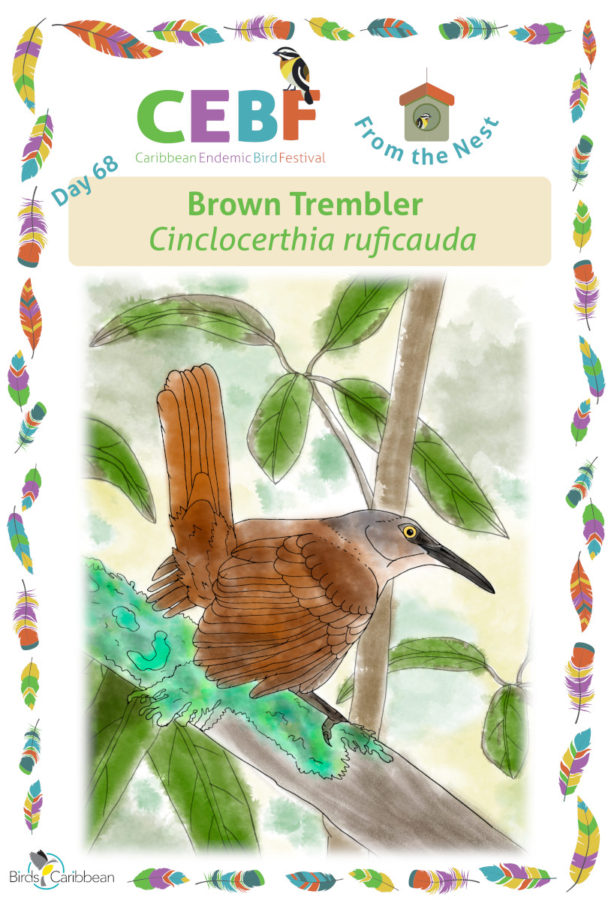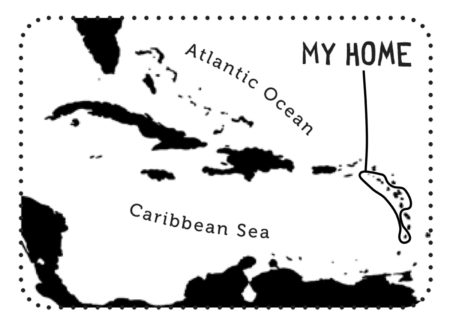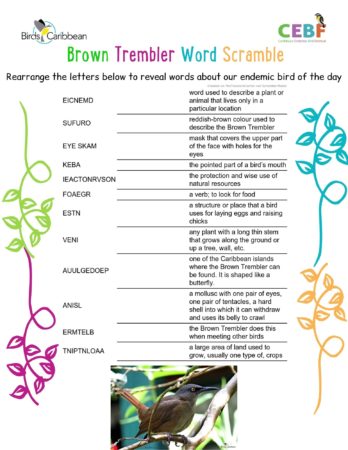Celebrate the Caribbean Endemic Bird Festival (CEBF) with us! Our theme in 2021 is “Sing, Fly, Soar—Like a Bird!” Have fun learning about a new endemic bird every day. We have colouring pages, puzzles, activities, and more. Download for free and enjoy nature with your family at home.
Endemic Bird of the Day: Brown Trembler
The Brown Trembler (Cinclocerthia ruficauda) is a plump, rufous-brown bird, 23–26 cm long. It has a long black beak, slightly decurved at the tip, and a long tail, often cocked over its back. Its flat head is grayish with a faint black eye mask, and it has bright yellow eyes. Males and females look alike but females have longer beaks.
Brown Tremblers live up to their name! They are best known for their curious habit of drooping their wings and trembling (fluttering) them, a behavior that helps you quickly identify this species. They tremble most often when meeting other tremblers, suggesting that the trembling may be a threat signal. They can also be identified by their distinctive warbling songs and calls. These range from one to three syllable phrases (pio-tareeu-tsee) to squeaky musical notes to a nasal rasping yeeeah call, often repeated many times. Brown Tremblers may not win a singing contest, but they have lots of personality.
Brown Tremblers can only be found in the Lesser Antilles; they are most common on Saba, St. Kitts, Guadeloupe, Montserrat, Dominica, and St. Vincent; uncommon in Nevis, and rare in St. Eustatius, St. Lucia, Martinique, and Antigua. They live in humid forests and sometimes may be found in secondary forests and plantations, as well as drier woodlands. They are smart foragers – on the ground, where they toss leaves in their beaks to find insects underneath, and in the trees. Their long, strong beaks come in handy as they stick them into spaces between vines, epiphytes, and tree trunks, or pull on leaves trapped in vegetation, in the forest’s understory and mid-story. Snails, scorpions, spiders, beetles, cockroaches, fruit, and even small lizards and frogs – all make tasty meals for the Brown Trembler.
Brown Tremblers are similar to the closely-related Gray Trembler (Cinclocerthia gutturalis) which has pale gray plumage above, more grayish-white underparts, a broader and dark black eye mask, and a longer bill. The Gray Trembler is found only in St. Lucia and Martinique.
Because this bird prefers humid forests, the conversion of forests to plantations or other human settlements could cause the population to decrease. You can help save this species by teaching others about this bird, and supporting forest conservation on your island. Learn more about this species, including its range, photos, and calls here.
Colour in the Brown Trembler
Download our West Indies Endemic Bird colouring page. Use the photos below as your guide, or you can look up pictures of the bird online or in a bird field guide if you have one. Share your coloured-in page with us by posting it online and tagging us @BirdsCaribbean #CEBFfromthenest
Listen to the song of the Brown Trembler
The song of the Brown Trembler is very variable, with a jumble of whistles and high-pitched notes.
Puzzle of the Day
Click on the image below to do the puzzle. You can make the puzzle as easy or as hard as you like – for example, 6, 8, or 12 pieces for young children, all the way up to 1,024 pieces for those that are up for a challenge!
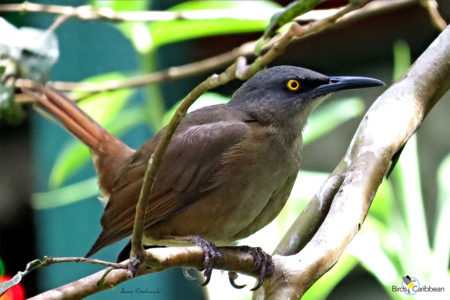
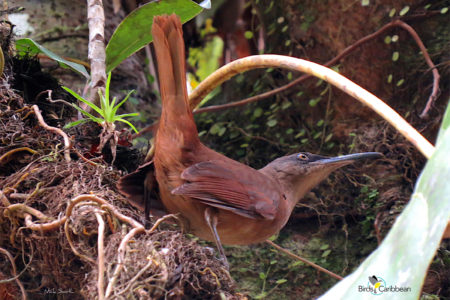
Activity of the Day
FOR KIDS: Use the information above and the clues on the sheet to untangle our our word scramble – all about todays endemic bird the Brown Trembler. With clues about how what is looks, what it likes to eat, how it behaves and where is lives! When you’ve finished you can check all the answers to the clues here.
FOR KIDS AND ADULTS: Enjoy these videos showing some of the behaviours of Tremblers! In the first video you can be today’s featured endemic bird, the Brown Trembler foraging amongst the branches of a tree, searching for insects to eat. The second video shows the similar Gray Trembler, which pale gray and not brown above, you can see this bird ‘trembling’. It is this fluttering behaviour that gives both these two bird species their name!

